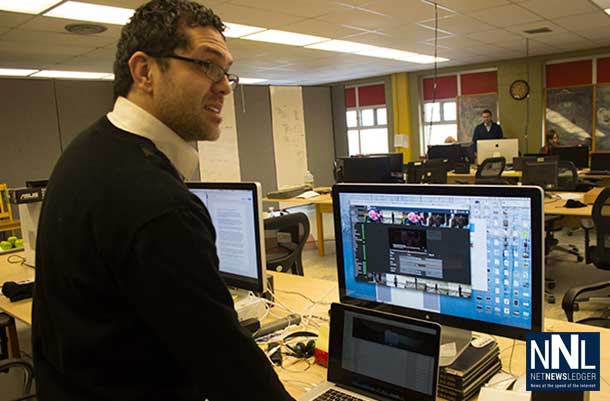

World Class Research in Thunder Bay
THUNDER BAY – Editorial – Thunder Bay has a thriving and growing technology and knowledge-based economy. In many cases it is developing, under the radar of many people. The Thunder Bay region is a great place for researchers to gather.
There are several companies, operating here in Thunder Bay bringing project team members from New York, and around the continent, to work on innovative projects. In their workspace in the Hillcrest Centre, if it were not for the snow falling outside the windows yesterday, you could have been in Silicon Valley in any number of world class companies.
Qwantech Growing ICT in Thunder Bay
Local software company, Qwantech, is working hard to bring Thunder Bay’s growing ICT community to the international forefront. Kevin Kuchta, Greg Hill, and the Qwantech team already have a number of large clients running their data collection and management systems, and have an exciting video-based product named klipmark set to be launched early in the new year. Last year Qwantech was also called to Dubai to receive an award at the 2012 Dubai Medical Informatics Conference and deliver a key-note presentation on their work in the field of Autism routine-management.
World Class is a term often tossed around easily. The innovation in our region is bluntly amazing.
Imaginarium – World Class Plus
Imaginarium here in Thunder Bay is on the leading edge of development of the next generation of digital video.
The development of research in Thunder Bay and across Northern Ontario is an area where the federal and provincial government have offered support. It is an area where even more support should be offered.
Five years ago, technology was different, you were not tweeting, you were not fixated to Facebook, and you were not watching movies on your iPhone. Technology is exploding with many new innovations that are changing our lives. The digital marketplace is full of new hi-tech products.
It is that change that for better or not is driving change in our world.

The innovation and changes in technology are going to revolutionize the next generations in our society.
James Murray
What Are the Next Innovations?
Today in New York, IBM (NYSE: IBM) unveiled the eighth annual “IBM 5 in 5” a list of innovations that have the potential to change the way people work, live and interact during the next five years.
- The classroom will learn you
- Buying local will beat online
- Doctors will routinely use your DNA to keep you well
- A digital guardian will protect you online
- The city will help you live in it
This year’s IBM 5 in 5 explores the idea that everything will learn – driven by a new era of cognitive systems where machines will learn, reason and engage with us in a more natural and personalized way. These innovations are beginning to emerge enabled by cloud computing, big data analytics and learning technologies all coming together, with the appropriate privacy and security considerations, for consumers, citizens, students and patients.
Over time these computers will get smarter and more customized through interactions with data, devices and people, helping us take on what may have been seen as unsolvable problems by using all the information that surrounds us and bringing the right insight or suggestion to our fingertips right when it’s most needed. A new era in computing will lead to breakthroughs that will amplify human abilities, assist us in making good choices, look out for us and help us navigate our world in powerful new ways.
“We know more now than any other generation at any time has known. And yet, we struggle to keep up with this flood of increasingly complex information, let alone make sense of the meaning that is inherent in the massive amounts of data we are acquiring at ever faster rates,” said Dr. Dario Gil, Director, Cognitive Experience Lab, IBM. “By creating technology that is explicitly designed to learn and enhance our cognition we will usher in a new era of progress for both individuals and for society at large.”
The IBM 5 in 5 is based on market and societal trends as well as emerging technologies from IBM’s Research labs around the world that can make these transformations possible.
Here are the five predictions that will define the future and impact us at a personal level:
The number of individuals who don’t have a sufficient education is a major global challenge. Estimates show that, on a global basis, nearly 2 out of every 3 adults have not achieved the equivalent of a high school education. What if a student could go through their entire stages of education and master the skills critical to meeting their personal goals in life?
The classroom of the future will give educators the tools to learn about every student, providing them with a tailored curriculum from kindergarten to high school and on to employment. In the next five years the classroom will learn about each student using longitudinal data such as test scores, attendance and student’s behavior on e-learning platforms, not just aptitude tests. Sophisticated analytics delivered over the cloud will provide decision support to teachers so they can predict students who are most at risk, their roadblocks, and then suggest measures to help students conquer their challenges based on their individual learning style.
IBM scientists are already getting to work in the classroom. In a first-of-a-kind research project with Gwinnett County Public Schools, the 14th largest school district in the US, IBM will leverage big data analytics and learning technologies for population analysis of longitudinal student records. The project aims to identify similarities of learning, predict performance and learning needs, then align specific content and successful teaching techniques to improve outcomes for each of the district’s 170,000 students and ultimately increase the district’s graduation rate.
Shopping online is a national past time. Online sales topped $1 trillion worldwide for the first time last year, and are growing faster than in-store sales.
Online stores currently have an advantage in their ability to learn from the choices we make on the web. Today, most physical stores are limited to the insights they can gain at the point of sale – and the trend of showrooming is making it harder to compete with online retailers who compete solely on price.
In five years, new innovations will make buying local du jour once again. Savvy retailers will use the immediacy of the store and proximity to customers to create experiences that cannot be replicated by online-only retail. They will magnify the digital experience by bringing the web right to where the shopper can physically touch it.
In five years, retailers could rely on Watson-like technologies to equip sales associates to be expert about every product in the store. With technologies such as augmented reality and the recently announced plan to open Watson as an app development platform, IBM is providing shoppers with better in-store browsing and buying experiences.
As mobile devices supported by cloud computing enable individuals to share what makes them tick, their health or nutritional needs, virtual closets and social networks, retailers will soon be able to anticipate with incredible accuracy the products a shopper most wants and needs. As a result, stores will transform into immersive destinations with experiences customized for each individual.
And given their proximity and multiple footprints, stores will be able to offer shoppers a variety of fast pick-up or delivery options, wherever the customer is. Two day shipping will feel like snail mail.
Doctors will routinely use your DNA to keep you well
Cancer is a complicated disease and despite tremendous advances in research and treatment, the incidence of cancer has risen more than 10 percent since 2008, striking more than 14 million patients and claiming the lives of 8.1 million every year around the world.
Imagine if treatment could be more specific and precise – where computers could help doctors understand how a tumor affects a patient down to their DNA and present a collective set of medications shown to best attack the cancer.
In five years, advances in big data analytics and emerging cloud-based cognitive systems coupled with breakthroughs in genomic research and testing could help doctors to accurately diagnose cancer and create personalized cancer treatment plans for millions of patients around the world. Smart machines will take the output of full genome sequencing and scour vast repositories of medical records and publications to learn and quickly provide specific and actionable insights on treatment options for oncologists.
Cancer care, personalized right down to a genomic level, has been on the horizon since scientists first sequenced the human genome, but few clinicians have access to the tools and time to assess the insights available at this level. Within five years, cloud-based cognitive systems could make such personalized medicine available at a scale and speed never before possible.
IBM is beginning to explore this opportunity, working with health care partners to develop systems that could deliver genomic insights and reduce the time it takes to find the right treatment for a patient from weeks and months to days and minutes.
These systems are destined to get even smarter over time by learning about people, their genomic information and response to drugs – opening up the possibility to provide DNA-specific personalized treatment options for conditions such as stroke and heart disease.
Through the cloud, smarter healthcare could scale to reach more people in more locations, while also giving a global community of healthcare providers access to vital information.
A digital guardian will protect you online
Today we have multiple IDs and devices than ever before, yet security is highly fragmented, leaving us vulnerable. In 2012 there were more than 12 million victims of identity fraud in the United States. Traditional approaches to security — passwords, anti-virus or a firewall – are not comprehensive. These rules-based approaches fall short in several ways – they are designed to recognize only known viruses or known fraudulent activity and typically only look at a single source of data.
In five years, each of us could be protected with our own digital guardian that will become trained to focus on the people and items it is entrusted with, offering a new level of identity theft protection. Security will assimilate contextual, situational and historical data to verify a person’s identity on different devices. By learning about users, a digital guardian can make inferences about what’s normal or reasonable activity and what’s not, acting as an advisor when they want it to.
Today, IBM scientists are using machine learning technologies to understand the behaviors of mobile devices on a network in order to assess potential risk. In the future, security is going to become more agile and contextual with a 360 degree of data, devices and applications, ready to spot deviations that could be precursors to an attack and a stolen identity.
The city will help you live in it
By 2030, the towns and cities of the developing world will make up 80 percent of urban humanity and by 2050, seven out of every 10 people will be a city dweller.
In five years smarter cities understand in real time how billions of events occur as computers learn to understand what people need, what they like, what they do, and how they move from place to place.
Soon it will be possible for cities and their leaders to understand and digest new information freely provided by citizens, knowing which city resources are needed, where and when, so the city can dynamically optimize around the needs of the citizens.
Mobile devices and social engagement will enable citizens to strike up a relationship with their city leaders. This concept is already in motion, for example, in Brazil, IBM researchers are working on a crowdsourcing tool that allows users to report accessibility problems, via their mobile phones, to help people with disabilities better navigate challenges in urban streets. While in Uganda, UNICEF is collaborating with IBM on a social engagement tool that lets youth communicate with their government and community leaders on issues affecting their lives.
These types of tools will become commonplace in helping city leaders identify trending concerns or urgent matters and immediately take action where needed.






